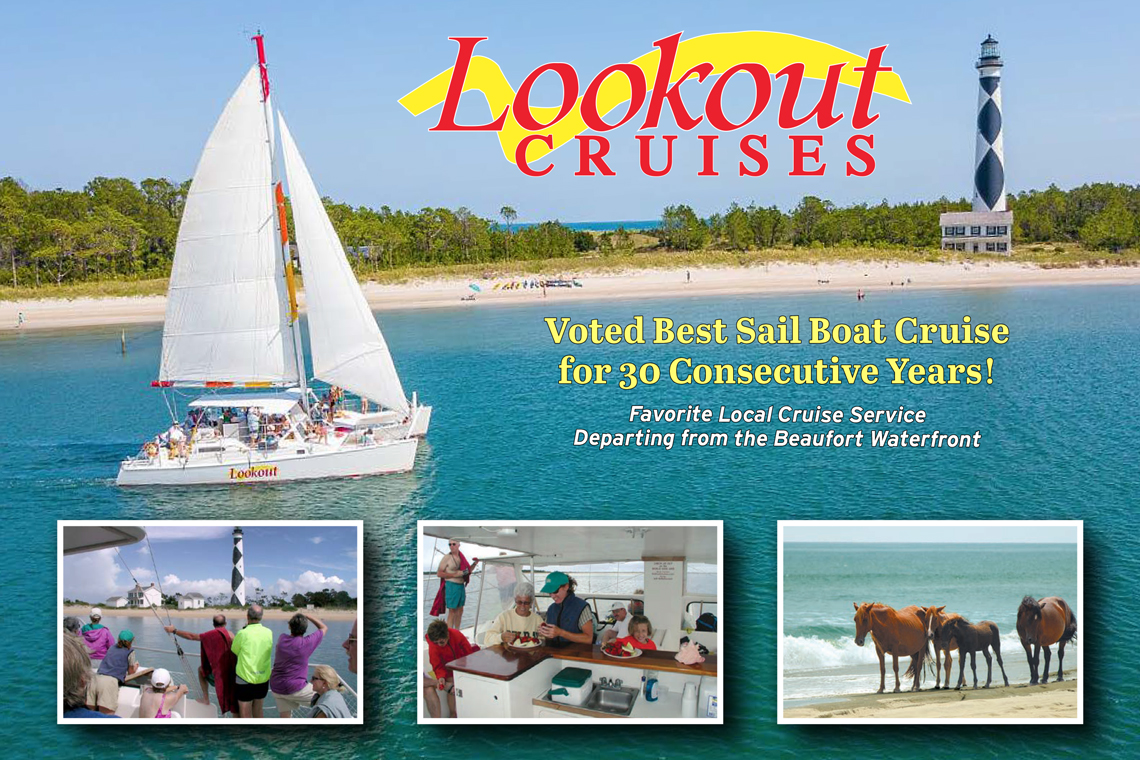
- Morehead City
- 252-504-2488
- Map it
Guide Sections
One of the best aspects of the Crystal Coast is that there is plenty of shoreline to go around. This string of barrier islands has more than 85 miles of coastline, which includes 56 miles of protected and unspoiled beaches that make up the Cape Lookout National Seashore. Because of this, folks will find plenty of stretches of sand where they can use their 4WD vehicle to cruise, explore, and find a remote beach spot to call their own.
If you’ve always wanted to explore the North Carolina beaches in the comfort of your 4WD vehicle, you’ll find ample options on the Crystal Coast that span from Portsmouth Island to Emerald Isle.
Here’s a closer look at each of these distinct regions, and the rules of the off-road when it comes to driving on the Crystal Coast beaches.

Portsmouth Island is a pristine, uninhabited barrier island that is part of the Cape Lookout National Seashore, and which is located just south of Ocracoke Island. This remote destination that is just 13 miles long is a haven for beachcombers, fishermen, birdwatchers, history buffs, and any visitor who loves an isolated shoreline that’s miles away from the rest of the world.
Once a busy port town along the North Carolina coast, Portsmouth Island is now deserted with the last full-time residents leaving in the 1970s. Even so, it’s still a very popular spot for 4WD fans and visitors, with lots of room to roam. In fact, except for seasonal closures due to sea turtle or endangered bird nesting, virtually all of the beaches are open for 4WD vehicle use, and multiple paths along the beach and tucked behind the oceanfront dunes exist so that visitors can easily cruise along the island.
How to get there:
The only way to access Portsmouth Island is by a privately owned and operated ferry. While ATV tours and day trips are available via Ocracoke Island, 4WD fans will want to take the Morris Marina Ferry out of the small town of Atlantic on the Crystal Coast mainland.
This ferry company has two vessels that provide seasonal transportation to and from Portsmouth Island from roughly March until the weekend after Thanksgiving. Fares vary based on vehicle type, and visitors are encouraged to book well in advance. Because the marina’s two ferries can only accommodate a handful of vehicles at a time, spots can fill up quickly.
Where to stay:
While accommodations are sparse and limited, Portsmouth Island is unique in that visitors can camp virtually anywhere they would like along the shoreline. It’s not unusual to see pick-up trucks outfitted with campers or specially designed 4WD RVs throughout the area, which allows folks to drive on the beach and stay comfortably throughout the trip.
In addition, Portsmouth Island is home to the Long Point Cabin Camp, which is a collection of rustic cabins that are managed by the Cape Lookout National Seashore, and which are located on the southern end of the island.
Long Point Cabin Camp features 10 duplex-style cabins which are close to the oceanfront, and which can individually sleep six people and measure about 500 square feet in area. Each of the units feature six bunk beds with mattresses, a table and chairs, a kitchen area with cabinets and a stove, a private bath, ceiling fans, and a hot water heater and lighting fixtures. Visitors will want to bring along their own bedding and towels, cookware and utensils, food, coolers, first-aid supplies, and anything else they might need during their stay.
For more information and availability, visit this page.
Beach Driving Rules and Regulations for Portsmouth Island:

Cape Lookout, (also known as the North Core Banks), is located in between Portsmouth Island and the Shackleford Banks, and is the middle undeveloped barrier island within the Cape Lookout National Seashore. This island is famed as being the home of the Cape Lookout Lighthouse, and like its neighbors, it is only accessible by boat or ferry, and has miles of pristine shoreline with few facilities or amenities.
The majority of the island is also open to beach driving, from the northernmost Off-Road Vehicle (ORV) Ramp 24 to the tip of Cape Lookout (Ramp 44.) As such, it’s easy for visitors to explore the entire island from the comfort of a 4WD truck or ATV, and to enjoy popular area activities including shelling, surf fishing, birdwatching, climbing the lighthouse, and just enjoying the isolated shoreline.
How to get there:
Like Portsmouth Island, visitors with a 4WD truck or ATV will want to access Cape Lookout via a privately owned vehicular ferry. There are two ferries in the area which access Cape Lookout - Davis Shore Ferry Service and Cape Lookout Cabins & Camps Ferry Service, which are both headquartered in the mainland town of Davis, NC.
Reservations are not always required, but are strongly recommended, as all ferries are fairly small, and can fill up quickly in the summer months. Ferries are seasonal, and may not operate in the winter months.
Where to stay:
Cape Lookout is home to one of the Cape Lookout National Seashore’s two campgrounds, the Great Island Cabins. This camp offers 25 cabins that can feature 4-12 bunk beds, and which range in size from 288 square feet to 960 square feet each.
Cabins can offer a private screened porch, a hot water heater, a private bathroom with shower, table and chairs, a propane oven / stove, and a charcoal grill. All cabins are also wired for 110 volt electricity, but visitors must supply their own generator, (less than 5500 watts), to use. In addition, visitors will want to bring along their own linens and bedding, cookware and food, and coolers, as the cabins are not equipped with refrigerators.
In addition to the established campground, visitors can also stay along the beach throughout Cape Lookout. Camping is prohibited at established visitor sites, like the Cape Lookout Light Station, or the Former U.S. Coast Guard Station.
Beach Driving Rules and Regulations:

Emerald Isle may be a hopping beach town in the summer months, but when it transforms into a quiet community in the winter, off-roading enthusiasts can take along their 4WD vehicles and explore the beaches.
There are three seasonally open ORV ramps located within the town of Emerald Isle, which is the southernmost beach community along the Crystal Coast. These ramps include the Ocean Drive "dog-leg" Ramp, (which is near mile marker 15 on NC 58), the Black Skimmer Drive Ramp, (which is across from the Police Department), and The Point Ramp, (which is at the very end of Inlet Drive at Bogue Inlet).
While the majority of beaches are seasonally open for 4WD vehicles, a permit is required, and visitors should note that certain sections of the shoreline may be closed for endangered bird or sea turtle nesting. That said, when open for explorers, a 4WD vehicle is a great way to discover multiple stretches of sand in this seasonal community that boasts a slow and remote atmosphere when the winter rolls around.
When you can drive on Emerald Isle beaches
Beach driving in the town of Emerald Isle is allowed from September 15 until April 30 every year, with the exception of the 10-day period from the Friday prior to Easter, and the Sunday seven days after Easter, when applicable. For example, in 2019, beach driving will not be allowed in Emerald Isle from April 19 - April 28.
In addition, beach driving is allowed from 9 a.m. until 9 p.m. every day from September 15 until November 4, and from March 10 to April 30, to allot for daylight savings time. From November 5 until March 9, daily driving hours are from 5 a.m. until 7 a.m.
Obtaining a Beach Driving Permit in Emerald Isle
In order to drive on the Emerald Isle beaches, an official Town of Emerald Isle beach driving permit is required, which is available for both residents and visitors.
A beach driving permit application is available online and fees can range from $50 for a resident or property owner to $100 for visitors. (Permit fees may be waived for special circumstances, including handicapped visitors, senior residents, and commercial fishermen.)
Permit applications can be returned via mail, fax, or email, or can be filled out and submitted in person at the Town Administration Building at 7509 Emerald Drive. Applications must also include a copy of the applicant’s driver’s license and vehicle registration card for the vehicle.

We've put together a short list of recommended items to get unstuck and stay safe. We like these linked products, but we took care to make sure they are highly-rated by many customers. Some of the product links include affiliate codes. *If a purchase is made, OuterBanks.com is paid a commission for the referral.
Do I need to have a 4WD vehicle to drive on the beach?
Due to the soft sand and lack of paved roads in the Cape Lookout National Seashore, a 4WD vehicle is required to drive on the beaches. Do not drive on the beach in an AWD vehicle.
Where is beach driving prohibited on the Crystal Coast?
Beach driving is not allowed on the southernmost island of the Cape Lookout National Seashore, (aka the Shackleford Banks), as well as the towns and communities of Atlantic Beach, Pine Knoll Shores, Salter Path, and Indian Beach.
How can I avoid getting stuck while driving on the beach?
All 4WD drivers should air down their tires to 20 psi or less to avoid getting stuck while on the beach. Follow the established tracks in the sand, and always carry along a board, shovel, and tow strap in case you do get stuck and need assistance. If you feel your tires start to spin, stop immediately and dig out a path, using the boards as extra support.
Are there tow truck companies on the Crystal Coast beaches in case I get stuck?
There are tow truck companies readily available in the Town of Emerald Isle, as well as on the Crystal Coast mainland. Note that if you do get stuck on the Cape Lookout National Seashore, it may take time for the tow truck to reach your vehicle, as ferry transport may be required.
Is there a speed limit to drive on the beaches?
The speed limit on the beaches in the Town of Emerald Isle is 20 mph, and speed limits for the Cape Lookout beaches are posted close to the entry ramps and throughout the shoreline.
What are the laws or rules for driving on the beach?
All state laws for driving on the highway in North Carolina apply to driving on the local beaches as well. This includes always wearing a seatbelt, having no open containers in the vehicle, and not driving while intoxicated.
Does it cost money to drive on the beach on the Crystal Coast?
A fee-based permit is required to drive on the beaches in the Town of Emerald Isle. A Beach Driving Certificate is required to drive on the Cape Lookout beaches, which is free.
Where can I get air for my tires after I have driven on the beach?
Local marinas and shops that service the vehicular ferries close to the Cape Lookout National Seashore generally have air for visitors to re-inflate their tires after driving on the beach. A number of gas stations close to 4WD beaches also offer air for free to beach drivers.
Can you drive on the beach at night?
Driving on the beach at night is allowed within the Cape Lookout National Seashore, but is prohibited in the Town of Emerald Isle.
Is saltwater bad for my vehicle?
Saltwater can degrade and ruin a vehicle. Avoid driving through the ocean wash and any standing brackish water near the dune lines.
Can I rent a 4WD vehicle to drive on the beach?
4WD vehicles may be available to rent in the Crystal Coast area in populated vacation communities such as Morehead City, Beaufort, and Emerald Isle.












